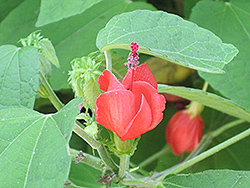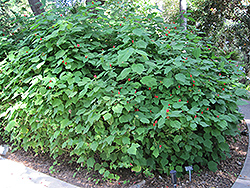It's all about ...
plants

Height: 16 feet
Spread: 12 feet
Sunlight:
![]()
Hardiness Zone: 9a
Other Names: Wax Mallow, Sleepy Hibiscus, Manzanilla
Description:
An interesting, large, freely branching shrub with slightly lobed, downy-green leaves, producing brilliant red flowers for most of the year; will tolerate light frost; prune to maintain size and density if desired; makes a great hedge or landscape screen
Ornamental Features
Turk's Cap features showy cherry red tubular flowers at the ends of the branches from late winter to late fall. The fruits are showy red drupes carried in abundance from late fall to mid winter. Its tomentose lobed palmate leaves remain green in colour with curious grayish green undersides throughout the year.
Landscape Attributes
Turk's Cap is a multi-stemmed evergreen perennial with an upright spreading habit of growth. Its relatively coarse texture can be used to stand it apart from other garden plants with finer foliage.
This is a relatively low maintenance plant, and should be cut back in late fall in preparation for winter. It is a good choice for attracting bees, butterflies and hummingbirds to your yard. It has no significant negative characteristics.
Turk's Cap is recommended for the following landscape applications;
- Mass Planting
- Hedges/Screening
- General Garden Use
- Container Planting
Planting & Growing
Turk's Cap will grow to be about 16 feet tall at maturity, with a spread of 12 feet. Although it is technically a woody plant, this fast-growing plant can be expected to behave as a perennial in our climate if planted outdoors over the winter, usually regrowing from its base (crown) the following year. As such, gardeners should take into consideration that it will perform differently than it would in its native habitat.
This plant should only be grown in full sunlight. It prefers to grow in average to moist conditions, and shouldn't be allowed to dry out. It is not particular as to soil type or pH. It is highly tolerant of urban pollution and will even thrive in inner city environments. This species is not originally from North America.
Turk's Cap is a fine choice for the garden, but it is also a good selection for planting in outdoor pots and containers. Its large size and upright habit of growth lend it for use as a solitary accent, or in a composition surrounded by smaller plants around the base and those that spill over the edges. It is even sizeable enough that it can be grown alone in a suitable container. Note that when growing plants in outdoor containers and baskets, they may require more frequent waterings than they would in the yard or garden. Be aware that in our climate, most plants cannot be expected to survive the winter if left in containers outdoors, and this plant is no exception. Contact our experts for more information on how to protect it over the winter months.
This plant is not reliably hardy in our region, and certain restrictions may apply; contact the store for more information.

